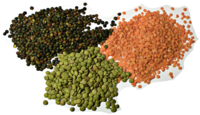
Toxicity evaluation of process water from hydrothermal carbonization of sugarcane industry by-products
Sign Up to like & getrecommendations! Published in 2018 at "Environmental Science and Pollution Research"
DOI: 10.1007/s11356-018-1771-2
Abstract: Hydrothermal carbonization (HTC) is a thermochemical process carried out in an aqueous medium. It is capable of converting biomass into a solid, carbon-rich material (hydrochar), and producing a liquid phase (process water) which contains the… read more here.
Keywords: hydrothermal carbonization; water; sugarcane industry; process water ... See more keywords

Hydrothermal carbonization of arecanut husk biomass: fuel properties and sorption of metals
Sign Up to like & getrecommendations! Published in 2018 at "Environmental Science and Pollution Research"
DOI: 10.1007/s11356-018-3888-8
Abstract: In this study, hydrothermal carbonization of arecanut husk and its potential application as an alternate solid fuel and heavy metal sorption (adsorbent) was attempted. Arecanut husk (AH) treated with citric acid for 9 h resulted in… read more here.
Keywords: carbonization arecanut; arecanut husk; fuel; hydrothermal carbonization ... See more keywords

Phytotoxicity and nutrition behavior of process water obtained from the hydrothermal carbonization of poultry litter and its effect on lettuce germination and growth
Sign Up to like & getrecommendations! Published in 2021 at "Environmental Science and Pollution Research"
DOI: 10.1007/s11356-021-14697-6
Abstract: Nine hydrothermal carbonization process waters (PWs) of poultry litter were prepared at 180, 220, and 260 °C for 1, 4, and 8 h, respectively. They were characterized with pH, EC (electric conductivity), DOC (dissolved organic… read more here.
Keywords: germination; poultry litter; lettuce germination; nutrition ... See more keywords

Activated carbon from citric acid catalyzed hydrothermal carbonization and chemical activation of salacca peel as potential electrode for lithium ion capacitor’s cathode
Sign Up to like & getrecommendations! Published in 2019 at "Ionics"
DOI: 10.1007/s11581-019-02904-x
Abstract: Activated carbon (AC) has been utilized for various applications including as an electrode for supercapacitor, i.e., electric double-layer capacitor (EDLC) as well as hybrid capacitor such as lithium ion capacitor. In this research, salacca peel… read more here.
Keywords: citric acid; salacca peel; carbon; capacitor ... See more keywords

Hydrothermal Carbonization of Microalgae (Chlorococcum sp.) for Porous Carbons With High Cr(VI) Adsorption Performance
Sign Up to like & getrecommendations! Published in 2018 at "Applied Biochemistry and Biotechnology"
DOI: 10.1007/s12010-018-2752-0
Abstract: Porous carbon adsorbents were prepared from microalgae (Chlorococcum sp.) via directly hydrothermal carbonization coupled with KOH or NH3 activation for Cr(VI) adsorption. KOH-activated porous carbons exhibit high Cr(VI) adsorption capacities than those obtained via NH3… read more here.
Keywords: adsorption; porous carbons; microalgae chlorococcum; high adsorption ... See more keywords

Performance of Liquids from Slow Pyrolysis and Hydrothermal Carbonization in Plant Protection
Sign Up to like & getrecommendations! Published in 2018 at "Waste and Biomass Valorization"
DOI: 10.1007/s12649-018-00545-1
Abstract: The feasibility of thermochemical biomass conversion technologies can be improved if value-added applications for all fractions can be developed. One of such approaches is the use of liquid by-products from slow pyrolysis and hydrothermal carbonization… read more here.
Keywords: plant protection; slow pyrolysis; pyrolysis; pyrolysis hydrothermal ... See more keywords

Solid fuel production from macadamia nut shell: effect of hydrothermal carbonization conditions on fuel characteristics
Sign Up to like & getrecommendations! Published in 2021 at "Biomass Conversion and Biorefinery"
DOI: 10.1007/s13399-021-01330-2
Abstract: Hydrothermal carbonization (HTC) was employed to convert macadamia nut shell (MCNS) into solid fuel. The effect of hydrothermal conditions was examined by varying the reaction temperature (170, 200, and 230 °C) and water/biomass ratio (2,… read more here.
Keywords: nut shell; hydrothermal carbonization; htc; solid fuel ... See more keywords

Adsorption of Basic Dyes Using Walnut Shell-based Biochar Produced by Hydrothermal Carbonization
Sign Up to like & getrecommendations! Published in 2018 at "Chemical Research in Chinese Universities"
DOI: 10.1007/s40242-018-8018-0
Abstract: Hydrothermal carbon(HC) was prepared from walnut shells, which are abundant in Northeastern China. The prepared HC was used as a precursor to produce nitric acid modified carbon(MC). The hydrothermal carbonization included dehydration and decarboxylation processes… read more here.
Keywords: carbonization; dyes using; adsorption basic; hydrothermal carbonization ... See more keywords

Characterization of products from hydrothermal carbonization of pine.
Sign Up to like & getrecommendations! Published in 2017 at "Bioresource technology"
DOI: 10.1016/j.biortech.2017.07.138
Abstract: This study aims to reveal the structural features and reaction pathways for solid-liquid products from hydrothermal carbonization of Loblolly pine, where the solid products can be used as catalysts, adsorbents and electrode materials while liquid… read more here.
Keywords: liquid products; characterization products; carbon; hydrothermal carbonization ... See more keywords

Characteristics of co-hydrothermal carbonization on polyvinyl chloride wastes with bamboo.
Sign Up to like & getrecommendations! Published in 2018 at "Bioresource technology"
DOI: 10.1016/j.biortech.2017.09.098
Abstract: The PVC waste and bamboo were treated by co-hydrothermal carbonization (co-HTC) at three different temperatures. The inorganic-Cl could be removed from the carbon rich solid products (hydrochar) in the form of HCl via hydrolysis, elimination,… read more here.
Keywords: bamboo; characteristics hydrothermal; dechlorination pvc; pvc ... See more keywords

Process characteristics for microwave assisted hydrothermal carbonization of cellulose.
Sign Up to like & getrecommendations! Published in 2018 at "Bioresource technology"
DOI: 10.1016/j.biortech.2018.03.010
Abstract: The process characteristics of microwave assisted hydrothermal carbonization of cellulose was investigated and a first order kinetics model based on carbon concentration was developed. Chemical properties analysis showed that comparing to conventional hydrothermal carbonization, hydrochar… read more here.
Keywords: assisted hydrothermal; carbonization; microwave assisted; characteristics microwave ... See more keywords